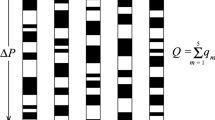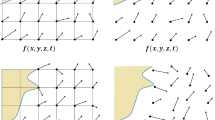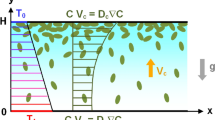Abstract
Riming growth of ice particles is simulated by numerically solving the stochastic collection equations, simultaneously considering coagulation of water droplets. By introducing a special criterion which defines the habit of a riming particle, the influence of this habit on the growth of several kinds of ice particles assumed to be formed during riming was investigated.
It was found that (i) hexagonal rimed ice plates are growing more efficiently than lump graupel or rimed columns, (ii) the use of different collection kernels for the lump graupel evolution leads to widely differing results and that (iii) the time dependent decrease of liquid water substance and the size of the resulting ice particles were more strongly influenced by the initial ice crystal concentration than by the initial ice crystal size and the habit of the ice particles. By decreasing the number density of ice crystals gradually a critical ice crystal concentration was found at which the present liquid water was not completely consumed by the riming process even after 1800 s model time, causing large drops of radii >100 μm to be formed in appreciable concentrations.
Similar content being viewed by others
References
Auer A. H., andVeal, D. L. (1970),The Dimension of Ice Crystals in Natural Clouds J. Atmos. Sci.27, 919–926.
Beard, K. V., andGrover, S. N. (1974),Numerical Collision Efficiencies for Small Rain Drops Colliding with Micron Size Particles, J. Atmos. Sci.31, 543–550.
Beheng, K. D. (1978),Numerical Simulation of Graupel Development, J. Atmos. Sci.35, 683–689.
Berry, E. X., andReinhardt, R. L. (1974),An Analysis of Cloud Droplet Growth by Collection: Part I-Double Distributions, J. Atmos. Sci.31, 1814–1824.
Heymsfield, A. (1972),Ice Crystal Terminal Velocities, J. Atmos. Sci.29, 1348–1357.
Locatelli, J. D., andHobbs, P. V. (1974),Fall Speeds and Masses of Solid Precipitation Particles, J. Geophys. Res.79, 2185–2197.
Ono, A. (1969),The Shape and Riming Properties of Ice Crystals in Natural Clouds, J. Atmos. Sci.26, 138–147.
Pflaum, J. C., andPruppacher, H. R. (1979),A Wind Tunnel Investigation of the Growth of Groupel Initiated from Frozen Drops. J. Atmos. Sci.36, 680–689.
Pitter, R. L., andPruppacher, H. R. (1974),A Numerical Investigation of Collision Efficiencies of Simple Ice Plates Colliding with Supercooled Water Drops, J. Atmos. Sci.31, 551–559.
Ryan, B. F. (1973),A Numerical Study of the Nature of the Glaciation Process, J. Atmos. Sci.30, 824–834.
Schlamp, R. J., Pruppacher, H. R., andHamielec, A. E. (1975),A Numerical Investigation of the Efficiency with which Simple Columnar Ice Crystals Collide with Supercooled Water Drops, J. Atmos. Sci.32, 2320–2337.
Author information
Authors and Affiliations
Rights and permissions
About this article
Cite this article
Beheng, K.D. Stochastic riming of plate-like and columnar ice crystals. PAGEOPH 119, 820–830 (1980). https://doi.org/10.1007/BF01131259
Received:
Revised:
Issue Date:
DOI: https://doi.org/10.1007/BF01131259




